The Cisco UCS 6536 Fabric Interconnect (UCSC-FI-6536) is a One-rack unit (1RU), top of rack (TOR), fixed-port data center
platform that provides both network connectivity and management capabilities to the Cisco UCS system.
The fabric interconnect can provide Ethernet and Fibre Channel connectivity to the servers in the system. The servers connect
to the fabric interconnect, and then to the LAN or SAN.
High availability and redundancy can be achieved by connecting a pair of fabric interconnects to each other through L1 or
L2 ports in cluster mode configuration.
Each Cisco UCS 6536 Fabric Interconnect offers the following features:
-
Thirty-six QSFP28 ports capable of 100G including 4 unified ports (33-36). Ports also support:
-
Autonegotiating with peer devices to speeds of 100G, 40G, 25G, 10G, and 1G.
-
Port breakout is supported for Ethernet ports (1-32) and Unified ports (33-36).
-
Ethernet breakout is supported on switch ports 1 through 36 when each port is configured with a breakout cable.
-
FC breakout is supported on ports 33 through 36 wherein each port is configured with a four-port breakout cable. For example
1/33/1, 1/33/2, 1/33/3, and 1/33/4 are the four FC breakout ports on the physical port 33.

Note
|
Fibre Channel support is only available through the configuration of Unified Ports (33-36) as FC breakout port.
|
-
FC breakout ports support peer communication at fixed speeds of 8Gbs, 16 Gbps, and 32 Gbps.
-
All four FC breakout ports must be configured with the same speed. Mixed speeds on a QSFP port's FC breakout ports are not
supported.
-
Using breakout ports enables the fabric interconnect to support the maximum 16 FC ports supported by Fibre Channel.

Note
|
-
Converting from Ethernet to FC breakout ports, or FC breakout ports back to Ethernet, requires a reboot/reload after changing
the breakout type.
-
FCoE storage ports are not supported.
|
-
One management port (one 10/100/1000BASE-T port)
-
Two L1/L2 Ethernet RJ-45 ports for high availability or cluster configurations. Ethernet ports support 10/100/1000Mb speed.
-
One console port (RS-232)
-
One USB 3.0 port
-
CPU: 4 Core, 1.8GHz, Intel 5th-Generation core processor
-
Memory:
This fabric interconnect includes the following user-replaceable components:
-
Fan modules (6), each is a port-side exhaust fan module with dark grey latch coloring (UCS-FAN-6536).
-
Power supply modules (2). One power supply module (PSU) is the active module for operations, and the second PSU is the standby
for redundancy [1+1]) with the following choices:

Note
|
All fan modules and power supplies must use the same airflow direction.
|
The following figure shows the fabric interconnect features on the port side of the chassis.

|
1
|
LEDs
|
3
|
36 40/100-Gigabit QSFP28 ports
|
|
2
|
Lane Select button
|
|
|
To determine which transceivers, adapters, and cables are support the fabric interconnect, see the Cisco Transceiver Modules Compatibility Information document.
The following figure shows the fabric interconnect features on the power supply side of the chassis.
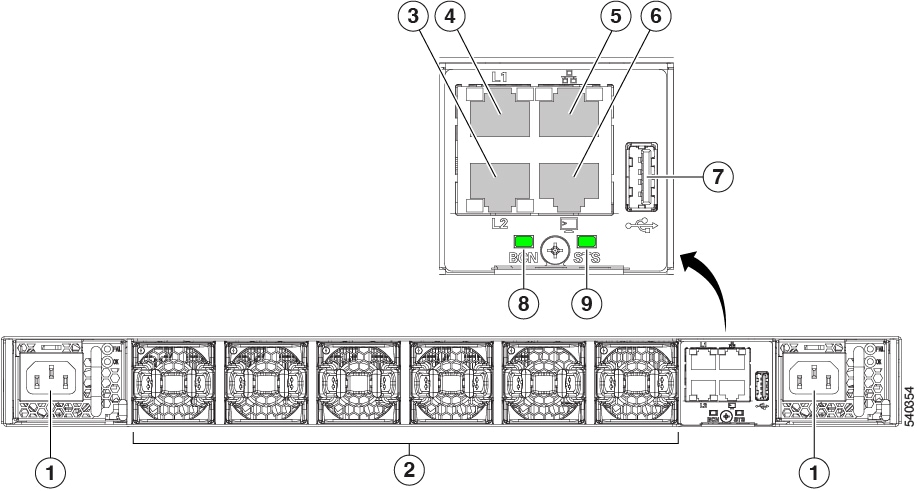
|
1
|
Power supply modules (1 or 2) (AC power supplies shown) with slots numbered 1 (left) and 2 (right).
|
2
|
Fan modules (6) with slots numbered from 1 (left) to 6 (right).
|
|
3
|
Layer 2 (L2) Ethernet port, 10/100/100Mb autonegotiating.
Supports high availability (HA) or clustering through an RJ-45 port.
|
4
|
Layer 1 (L1) Ethernet port, 10/100/100Mb autonegotiating.
Supports high availability (HA) or clustering through an RJ-45 port.
|
|
5
|
Ethernet network management port (RJ45), 10/100/1000Mb autonegotiating
|
6
|
Serial Console port (RJ45), 9600 baud.
|
|
7
|
USB 3.0/2.0 port
Supports booting the system and downloading scripts.
|
8
|
Beacon (BCN) LED
|
|
9
|
Status (STS) LED
|
-
|
|
The following figure shows the side of the chassis.
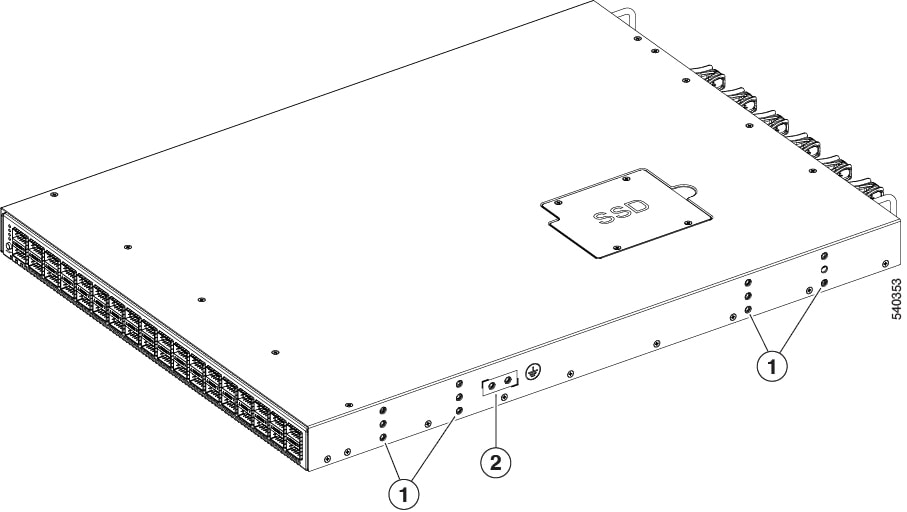
|
1
|
Screw holes for mounting brackets
|
2
|
Grounding pad
|
Plan to position the ports in a hot aisle so that fans and power supplies intake air from the cold aisle, blow the cool air
through the fabric interconnect, and exhaust the heated air into the hot aisle.
The fan and power supply modules are field replaceable. You can replace one fan module or one power supply module during operations
so long as the other modules are installed and operating. If you have only one power supply installed, you can install the
replacement power supply in the open slot before removing the original power supply.

Note
|
All fan and power supply modules must have the same direction of airflow. Otherwise, the fabric interconnect can overheat
and shut down.
|

Caution
|
Because fans and power supply modules have port-side exhaust airflow (blue coloring for fan modules), you must locate the
ports in the hot aisle. If you locate the air intake in a hot aisle, the fabric interconnect can overheat and shut down.
|
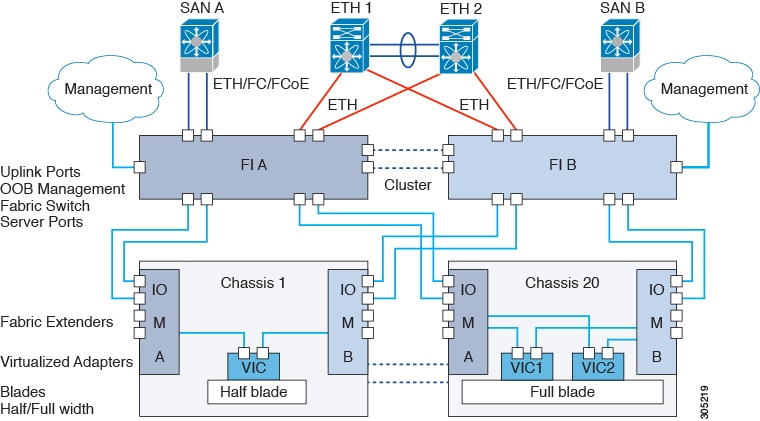

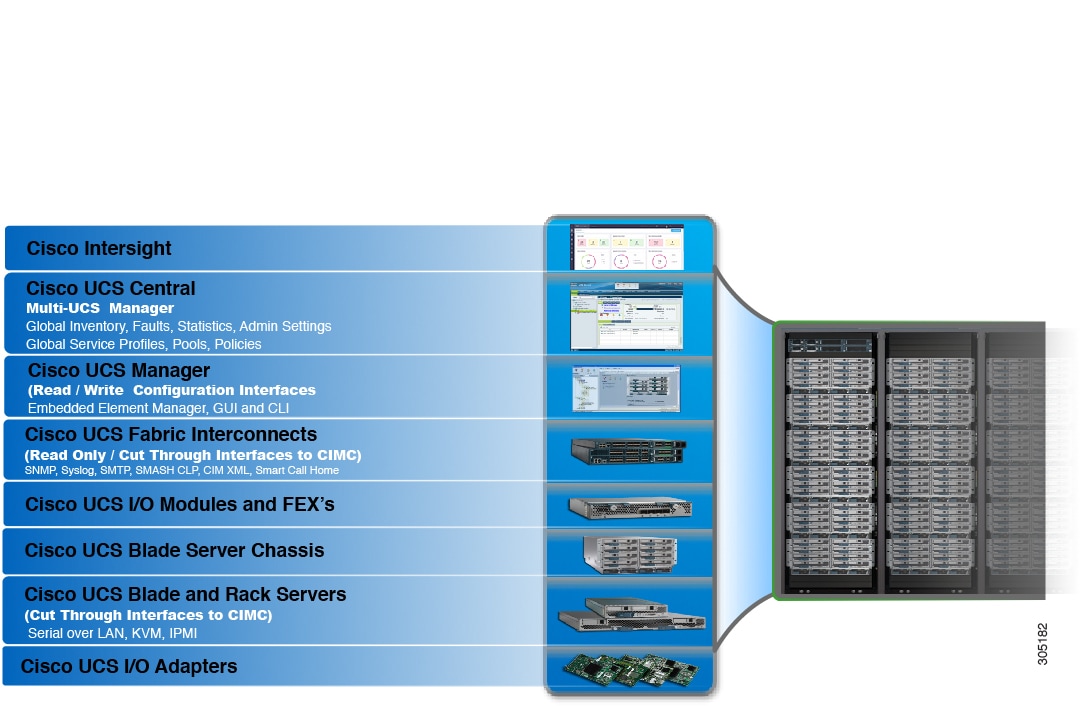





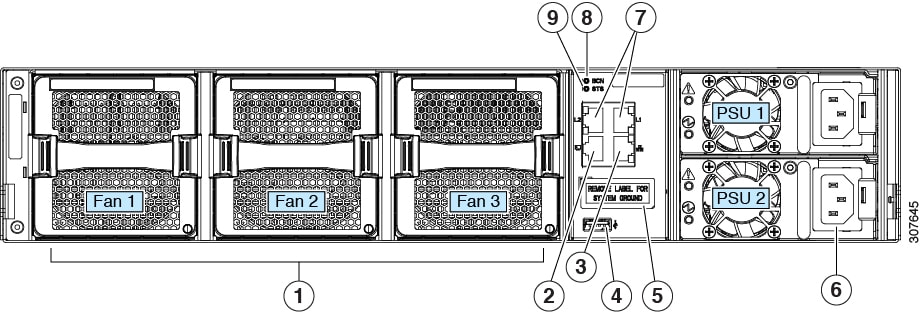











 Feedback
Feedback